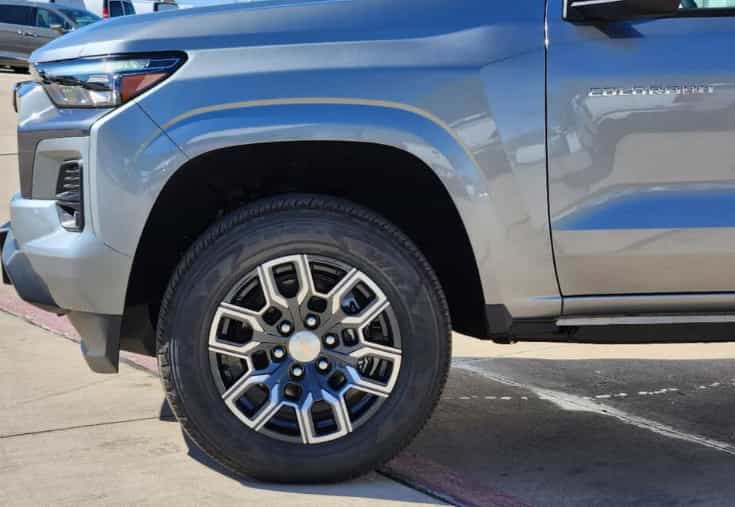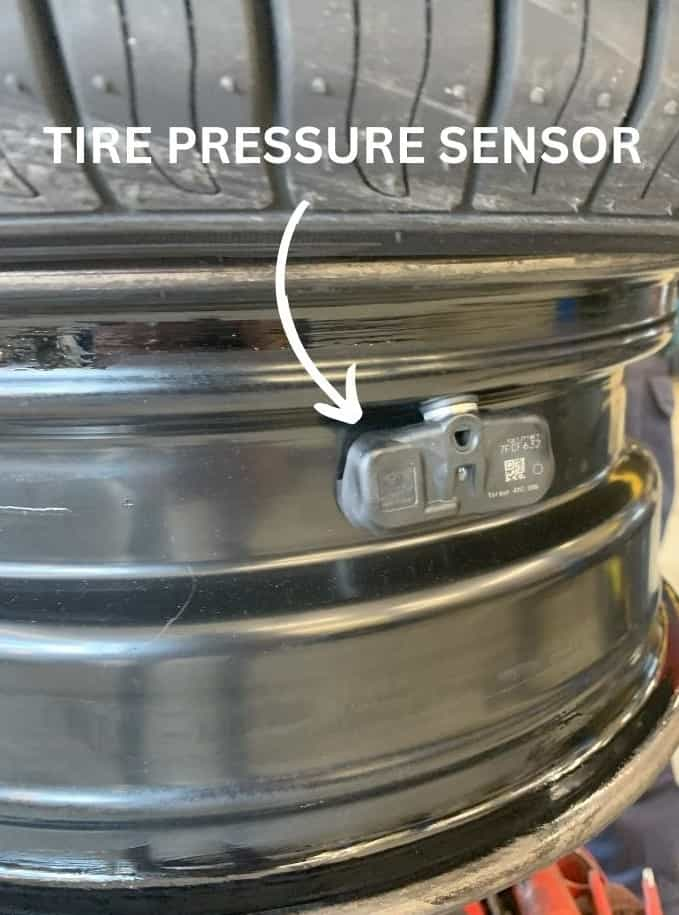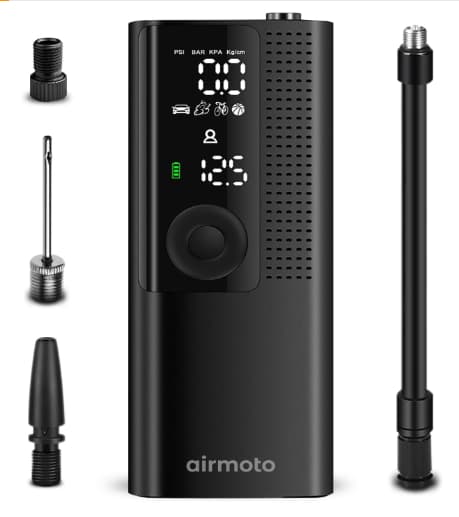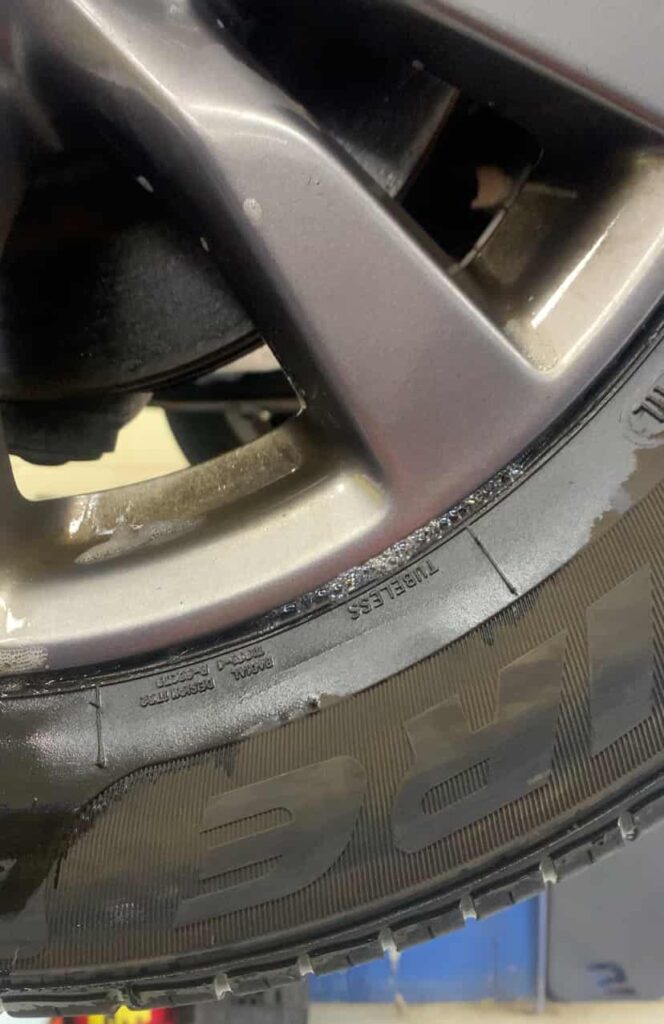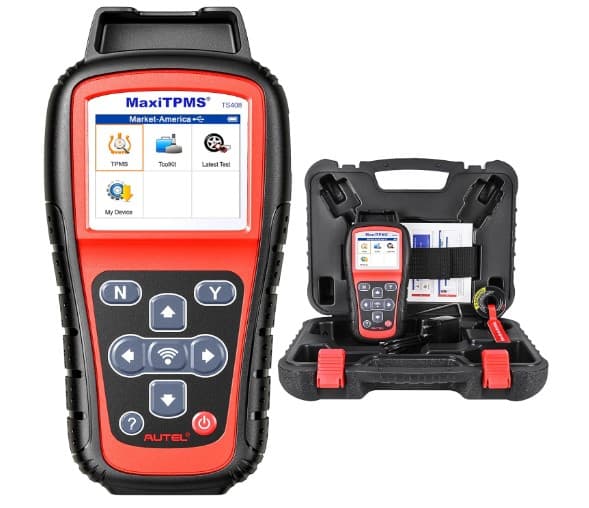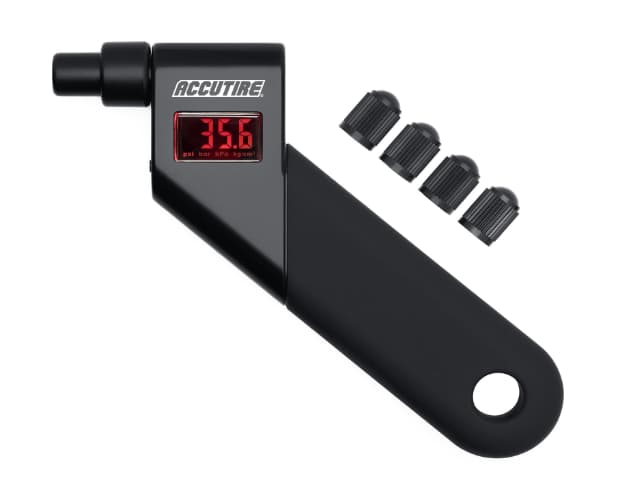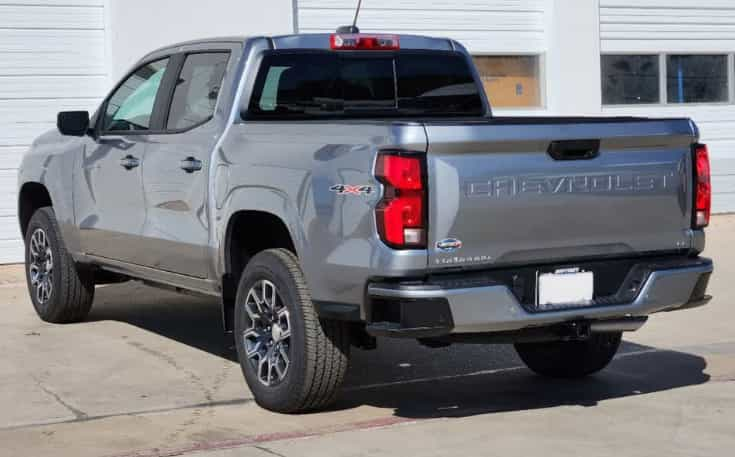Steps to Reset the Chevy Colorado Tire Light Without a Reset Button
The Chevrolet Colorado doesn’t have a TPMS reset button.
Wait for the truck’s tires to be in a cold state.
Ensure each of the Chevy Colorado’s tires are inflated to the recommended air pressure found on the driver side door panel.
Take the Chevy Colorado for a spin at speeds over 25 Mph for a few minutes.
How to Put the Chevy Colorado TPMS into Relearn Mode
After any tire services or sensor replacements in the Chevrolet Colorado, adhere to the tire pressure sensor relearning guideline below. It’s essential for the truck’s ECM to learn the location of each tire pressure sensor.
Inflate each of the truck’s four tire’s pressure to 40 Psi.
Turn the Chevrolet Colorado’s ignition on while keeping the engine off.
From the dashboard screen, select “Menu.”
Navigate to “Vehicle Information.”
Select “Tire Pressure Menu.“
Press and hold the SET/CLR button.
A message will appear on the display reading “Are you sure you want to relearn?”
Select “Yes.”
Two consecutive horn sounds indicate you are now in tire pressure sensor relearn mode and the phrase “TIRE LEARNING ACTIVE” will pop on the screen.
Release air from the driver side front tire until you hear the horn beep.
Sequentially attend to front right, back right, and back left tires in that order.
After hearing the horn beep after deflating each tire, you have successfully completed the Chevy Colorado tire pressure sensor relearn procedure.
Turn the ignition off and inflate all the tires back to their recommended air pressures.
sfrds
IMPORTANT: Adhere to the Chevy Colorado tire pressure sensor relearn sequence as listed: LF, RF, RR, RL.
What is the Chevy Colorado TPMS?
Your Chevrolet Colorado has a TPMS (tire pressure monitoring system) that might not always get the recognition it deserves. This system, including the Colorado’s ECM, a TPMS receiver module, and four tire monitoring sensors, synchronizes to relay tire pressure data on the Tahoe’s interface and sends alerts during low-pressure situations.
How Does the Chevy Colorado TPMS Work?
Tire Pressure Sensors:
Every Chevrolet Colorado wheel and tire contains a dedicated TPMS sensor.
Positioned at the base or end of the valve stem, often hidden unless the tire is removed.
Each sensor actively monitors the tire’s air pressure and temperature.
TPMS sensors are made up of a circuit board, a transmitter, and a battery.
Data Transmission:
The built-in transmitter in the sensors employs radio waves for data communication.
The tire pressure sensor data contains real-time information about the tire’s condition and is relayed to the Chevy Colorado’s TPMS receiver module.
TPMS Receiver Module:
Acts as an intermediary, collecting data from all the vehicle’s tire sensors.
It then channels this data to the Colorado’s central computing system, the ECM.
ECM (Electronic Control Module):
The brain behind the operation; it evaluates the incoming tire data.
Compares current readings with the Chevrolet Colorado’s prescribed standards for tire pressure and temperature.
Dashboard Alerts:
A yellow or orange exclamation mark symbol on the dashboard if tire pressure drops below the Colorado’s tire pressure threshold.
A “Low Tire Alert” message might also appear on the information display.
TPMS Self-diagnostic Feature:
The Chevy Colorado TPMS has a system in place to monitor the health of the TPMS itself.
If there’s a malfunction or the system isn’t working as intended, the dashboard’s tire pressure alert light will flash, signaling the driver to take action.
2023 Chevy Colorado Tire Air Pressure & Wheel Size
TIRE SIZE | FRONT PSI | REAR PSI |
255/65R17 | 35 | 35 |
265/65R17 | 35 | 35 |
265/60R18 | 35 | 35 |
Reasons The Chevy Colorado Tire Pressure Light Turns On:
Incorrect tire inflation (too low or high)
Tires losing air
Missing tire pressure sensors in tires
TPMS sensor batteries on the decline or faulty
Damaged/faulty or out of date software in the TPMS receiver module or Chevy Colorado’s ECM
Electromagnetic disruption from nearby electronics or other vehicles
Changes in air temperature
Surpassing vehicle’s load or weight limits
Putting chains on tires
Heavy window tinting
Temperature shifts on the road
Different tire sizes mounted on the truck
TPMS sensors harmed during tire installation
Overlooking TPMS recalibration or tire pressure sensor relearn procedure after tire swaps or tire rotations
Valve stem or valve stem core leaks
Tire bead seal leaks
How Long Do Chevy Colorado Tire Pressure Sensors Last?
Within the wheels of the Chevy Colorado, a tiny silver oxide battery powers each tire pressure sensor. With an average life expectancy of 5-10 years or a mileage range of 100,000-150,000 miles, these batteries facilitate the functioning of the sensor’s transmitter and circuit board. However, once a Chevy Colorado TPMS sensor battery diminishes or runs out, it can’t be rejuvenated or swapped out, making the entire sensor’s replacement necessary.
6 Steps To Identify Why the Chevy Colorado Tire Light is On:
For those driving a Chevy Colorado, the tire pressure light can be a challenge. To aid in identifying the reason it’s on and finding ways to switch it off when the typical TPMS reset and sensor relearn isn’t effective, consider the following tips.
1: NEXT STEPS WHEN CHEVY COLORADO'S TIRE LIGHT REAPPEARS AFTER INITIAL RESET
If you’ve topped up all the tires to the recommended 35 Psi and the warning light goes off, your Chevy Colorado’s tire pressure system is doing its job. However, if that light reactivates after switching off, one of your tires might have a slow leak. It’s advisable to manually gauge the tire pressures once more to identify the compromised tire.
2: 5 STEPS TO LOCATE A LEAK IN YOUR CHEVY COLORADO
Once you’ve singled out the tire with pressure issues, follow the below steps to identify the exact leak spot.
You’ll Need: Tire compressor, spray bottle, water, and soap.
Instructions:
Fill up the affected tire to a pressure in the range of 35-40 Psi using your tire compressor.
Combine water and soap in the spray bottle. (Windex can be used as an alternative.)
Thoroughly douse the tire with your soapy solution.
Look out for bubbles forming on the tire.
Track the source of these bubbles.
🔍Advice: Leaks found on the tread can often be fixed using a patch or a plug. If the leak is on the bead seal, a bead sealing is required. Should the leak arise from the valve stem, replace the valve stem.
3: USING A TPMS PROGRAMMING TOOL TO FIND OUT IF A TIRE PRESSURE SENSOR IS FAULTY
If you have a hunch that a malfunctioning TPMS sensor is triggering the tire pressure light in your Chevy Colorado, a TPMS programming/relearn tool can be invaluable. I’ve consistently turned to Autel TPMS diagnostic tools for such purposes in my own shop. To get started, connect the TPMS tool to the Chevy Colorado through its OBD2 interface. The tool then proceeds to scrutinize each sensor, offering insights on metrics like current sensor battery lifespan, tire’s current temperature, and TPMS sensor signal robustness.
🔍Insight: Should the diagnostic feedback highlight issues like sensor battery depletion, bizarre temperature stats such as -166 degrees, or compromised transmission signals, consider replacing that particular sensor ASAP.
4: WILL DISCONNECTING THE BATTERY RESET THE TPMS?
Whenever the Chevy Colorado’s engine control module detects a low tire pressure, it’s stored in its digital memory. To potentially clear this record, you can sever its connection to the truck’s primary power source, the 12-volt battery.
Disconnect the negative terminal from the battery.
Allow a brief interval before re-establishing the connection and ensuring it’s tightly fastened.
Subsequently, drive the Chevy Colorado for a duration of 30 minutes, maintaining a consistent speed of 50 Mph.
🔍Observation: If, after these steps, the tire indicator dims but reactivates during transit, it implies that the Chevrolet Colorado might have a tire pressure sensor running low on battery or a tire that’s losing air pressure. Make sure your tires are correctly inflated before following this process.
5: TROUBLESHOOTING TPMS RELEARNING IN THE CHEVY COLORADO WITH AIR PRESSURE ADJUSTMENTS
If you’re finding the Chevy Colorado TPMS relearning process unfruitful, here’s an alternative tactic:
Lower the pressure of the problematic tire by about 15 Psi.
Utilize a tire compressor to elevate the pressure to 40 Psi, surpassing the recommended 35 Psi by 5 extra psi.
Drive the Colorado for a brief period while the tire remains over-pressurized.
After driving, circle back to the TPMS relearn procedure for the Chevy Colorado as detailed above.
6: UNDERSTANDING TEMPERATURE-INDUCED TIRE PRESSURE CHANGES IN THE CHEVY COLORADO
Both tire and ambient temperatures considerably affect the Chevy Colorado’s tire pressure. A widely accepted principle is that a tire’s pressure will deviate by 1 Psi for every 10-12°F temperature difference. Imagine parking your Chevy truck overnight at 75°F, only to find that by dawn, with temperatures at 37°F, the tire pressure warning is illuminated. This is due to the roughly 4 psi reduction from the 40°F overnight temperature descent. In contrast, as temperatures rise, either from environmental factors or active driving (driving heats tires up), the tire pressure increases. This fluctuation can cause the Chevy truck’s tire pressure warning to turn on and then subsequently off without any manual intervention.
🔍A prime solution to this challenge is to calibrate your tires’ pressure after allowing them to cool – ideally, waiting about 3 hours post-driving – to ensure accurate readings reflective of their “cold recommended” condition. This will prevent underinflation and overinflation in your Chevy truck.
CHEVY COLORADO TIRE PRESSURE INFORMATION
LOW TIRE PRESSURE AFFECTS ON THE CHEVY COLORADO'S GAS MILEAGE
In the Chevy Colorado, the relationship between tire pressure and fuel economy is direct and undeniable. Proper tire inflation reduces the tire’s friction on the road, enhancing efficiency. However, a decrease of just 1 PSI below the recommended tire pressure can lead to a 0.2% reduction in the car’s gas mileage. When compounded over numerous journeys, this inefficiency could mean several additional trips to the gas station, emphasizing the necessity of maintaining the right tire pressure for the truck’s performance, impact on the environment, and the owner’s wallet.
ENSURING PROPER TPMS FUNCTION AFTER CHEVY COLORADO WHEEL AND TIRE REPLACEMENTS
If you decide to fit new tires on your Chevy Colorado, always stick to the TPMS reset and tire pressure sensor relearn guidelines. Additionally, if you replace the Chevy Colorado’s wheels, it’s crucial either to move the existing tire pressure sensors to the new set or to invest in a new set of four sensors. Subsequently, program them to the Colorado’s ECM using a TPMS programming tool.
SHOULD YOU KEEP DRIVING WITH THE TIRE LIGHT ON?
Driving with an activated low tire pressure light isn’t recommended. Ensure you manually inspect the Chevy Colorado’s tire pressures using a reliable air pressure gauge to identify the root of the tire warning. Once the cause is known, you can gauge the prudence of continuing to drive.
HOW FAR SHOULD YOU DRIVE WITH AN ACTIVE TIRE ALERT IN THE CHEVY COLORADO?
Your driving distance in the Chevy Colorado with an active tire light should hinge on the underlying issue causing the alert. If it’s due to a tire losing pressure, stop and resolve the problem at once.
WHY IS THE CHEVY COLORADO LOW TIRE LIGHT FLASHING?
Your Chevy Colorado’s tire light will flash if there’s a communication fault between the tire pressure sensors and the truck’s TPMS receiver module or ECM. This is often linked to a TPMS sensor with a weak battery or the use of the spare tire, which doesn’t contain a sensor. This scenario is known as a TPMS malfunction.
CHOOSING THE RIGHT TIRE REPAIR METHOD
In our shop, we frequently utilize tire plugs to effectively address tire punctures. For more extensive damage, tire patches are our suggestion. If the damage is on the sidewall or the tire tread is minimal, a new tire is the best course of action.
PRECAUTIONS FOR USING TIRE SEALANTS WITH ELECTRONIC TIRE SENSORS
By employing tire sealants such as fix-a-flat or slime, you’re filling the tire with a liquid as a short-term solution. But, considering the presence of electronic tire sensors inside, there’s a chance the sealant could impair the tire pressure sensor. After using any tire sealant, it’s advisable to assess the Chevy Colorado’s tire pressure sensors for possible harm.
Everything in this article is applicable to all Chevrolet Colorado models and versions including the Chevy Colorado ZR2, LT, TRAIL BOSS, WT, and Z71.
Please note that this blog post contains Amazon affiliate links. This means that if you make a purchase through one of these links, we at TPMSRESET.COM may earn a small commission at no extra cost to you. We only recommend products that we personally use and believe in. Thank you for supporting us.

